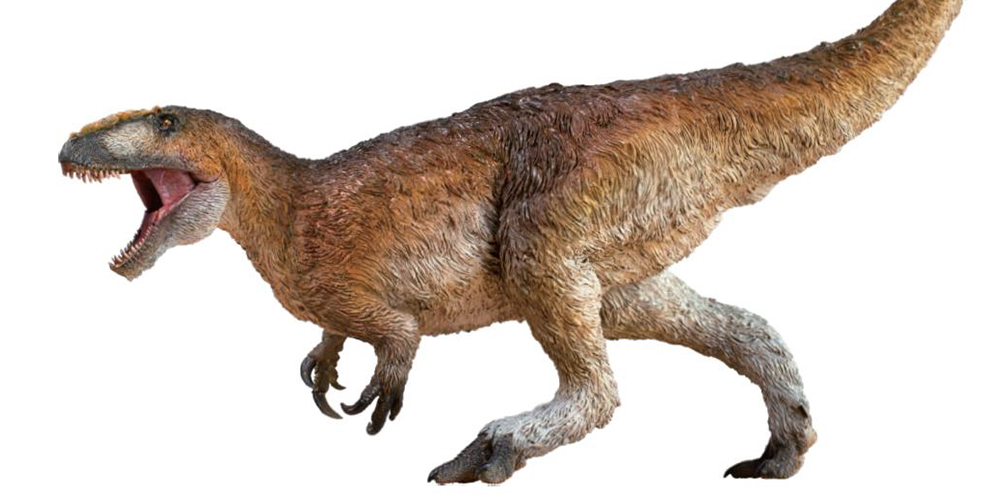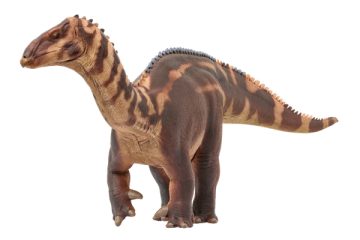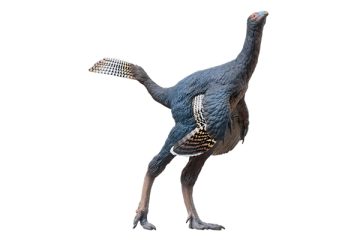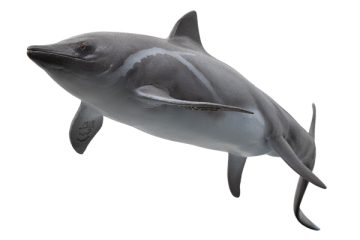
Stories written by: YANG Yang
Who is Yinqi the Yutyrannus?
Yutyrannus, a member of tyrannosaurs, is the largest feathered dinosaur discovered so far. Yutyrannus lived in the early Cretaceous period, with its fossils unearthed in Liaoning, China. Because their fossils are well preserved and contain individuals of different ages, scientists can thoroughly study them. It also allows our restoration to proceed smoothly.

Model Size/25.5cm X 5.5cm X 12.3cm
Model Material/ Environment-friendly PVC, hand painting
Model Structure/Solid Structure
Package Size/28cm X 6.2cm X 13cm
Inside Package/ Model + A3 Poster + Product Manual
Transparent Support/Yes
How did ZHAO Chuang and YANG Yang create Yinqi the Yutyrannus?
The Size of Yinqi the Yutyrannus
Yutyrannus was a large carnivorous dinosaur. Judging from the adult specimens collected, their body length could reach 9 meters, and their weight was about 1.4 tons. We referred to this standard when we restored Yinqi the Yutyrannus.

The Head of Yinqi the Yutyrannus
Yutyrannus was a relatively primitive tyrannosaur, with its skull distinguished from that of late tyrannosaurs. Their heads were relatively narrow and long, with a prominent crest on the top, long nostrils, and a low crest on the nose. In our restoration, you can clearly see these characteristics.
The Forelimbs of Yinqi the Yutyrannus
The forelimbs of Yutyrannus were vastly different from the short and small ones of late tyrannosaurs. They were well developed, with three fingers and sharp claws at the end. We emphasized this feature in our restoration.

The Hands of Yinqi the Yutyrannus
Regarding the restoration of the hands of Yutyrannus, there are two different views: one is that their fingers were similar to the toes of birds, covered with scales, which can maximize the grasping ability of the fingers; another is that their fingers were covered with feathers. Our restoration of this model adopted the former view.
The Hindlimbs of Yinqi the Yutyrannus
Because the hindlimb fossils of Yutyrannus are preserved completely, we can restore them accurately. In our restoration, you can see that the hindlimbs of Yinqi the Yutyrannus are slender and robust, with four toes on each foot, and the feathers on their hindlimbs cover all the way to the toes.

The Trunk of Yinqi the Yutyrannus
Judging from the fossils alone, the trunk of Yutyrannus was slim, but because they were covered with thick feathers, their bodies looked chubby when alive.
The Tail of Yinqi the Yutyrannus
Yutyrannus had a very long tail covered with some feathers, but we don’t know where these feathers would cover. When we restored the tail of Yinqi the Yutyrannus, we took reference to a primitive tyrannosaur, Dilong, which had relatively complete tail fossils.
Learn while Play
Subscribe to PNSO.Official YouTube channel. Get to know Yinqi the Yutyrannus with ZHAO Chuang in the playlist of PNSO Prehistoric Animal Models-Get to Know Dinosaurs. Learn to draw Yinqi the Yutyrannus with ZHAO Chuang in the playlist of PNSO Prehistoric Animal Models-Learn to Draw Dinosaurs.



